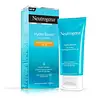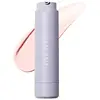What's inside
What's inside
 Key Ingredients
Key Ingredients

 Benefits
Benefits

 Concerns
Concerns

 Ingredients Side-by-side
Ingredients Side-by-side

Water
Skin ConditioningGlycerin
HumectantHomosalate
Skin ConditioningCaprylyl Methicone
Skin ConditioningEthylhexyl Salicylate
UV AbsorberButyl Methoxydibenzoylmethane
UV AbsorberPhenylbenzimidazole Sulfonic Acid
UV AbsorberOctocrylene
UV AbsorberSodium Acryloyldimethyltaurate/Vp Crosspolymer
Emulsion StabilisingSilica
AbrasiveSodium Hyaluronate
HumectantTocopheryl Acetate
AntioxidantDicaprylyl Carbonate
EmollientGlyceryl Stearate
EmollientSteareth-21
CleansingSodium Polyacrylate
AbsorbentDisodium EDTA
Sodium Hydroxide
BufferingSodium Ascorbyl Phosphate
AntioxidantTocopherol
AntioxidantBenzyl Alcohol
PerfumingChlorphenesin
AntimicrobialPhenoxyethanol
PreservativeParfum
MaskingCI 16035
Cosmetic ColorantCI 42090
Cosmetic ColorantWater, Glycerin, Homosalate, Caprylyl Methicone, Ethylhexyl Salicylate, Butyl Methoxydibenzoylmethane, Phenylbenzimidazole Sulfonic Acid, Octocrylene, Sodium Acryloyldimethyltaurate/Vp Crosspolymer, Silica, Sodium Hyaluronate, Tocopheryl Acetate, Dicaprylyl Carbonate, Glyceryl Stearate, Steareth-21, Sodium Polyacrylate, Disodium EDTA, Sodium Hydroxide, Sodium Ascorbyl Phosphate, Tocopherol, Benzyl Alcohol, Chlorphenesin, Phenoxyethanol, Parfum, CI 16035, CI 42090
Zinc Oxide 15.5%
Cosmetic ColorantWater
Skin ConditioningC12-15 Alkyl Benzoate
AntimicrobialCaprylic/Capric Triglyceride
MaskingButyloctyl Salicylate
Skin ConditioningDimethicone
EmollientGlycerin
HumectantEthylhexyl Palmitate
EmollientPropanediol
SolventButyrospermum Parkii Butter
Skin ConditioningCarthamus Tinctorius Oleosomes
EmollientGlyceryl Stearate Se
EmulsifyingButylene Glycol
HumectantPolyhydroxystearic Acid
EmulsifyingSorbitan Isostearate
EmulsifyingCetyl Alcohol
EmollientNiacinamide
SmoothingPentaerythrityl Tetraisostearate
EmollientPhenyl Trimethicone
Skin ConditioningSilica
AbrasiveHyaluronic Acid
HumectantSodium Hyaluronate
HumectantCitrullus Lanatus Seed Extract
Skin ConditioningAdansonia Digitata Pulp Extract
EmollientBarosma Betulina Leaf Extract
PerfumingAloe Barbadensis Leaf Juice
Skin ConditioningTocopherol
AntioxidantGluconolactone
Skin ConditioningInulin Lauryl Carbamate
Emulsion StabilisingHydroxyethyl Acrylate/Sodium Acryloyldimethyl Taurate Copolymer
Emulsion StabilisingXanthan Gum
EmulsifyingHydroxyacetophenone
AntioxidantPolysilicone-11
Trisodium Ethylenediamine Disuccinate
Sodium Citrate
BufferingCitric Acid
BufferingBenzyl Salicylate
PerfumingEthylhexylglycerin
Skin ConditioningSodium Benzoate
MaskingPotassium Sorbate
PreservativePhenoxyethanol
PreservativeParfum
MaskingHexyl Cinnamal
PerfumingLimonene
PerfumingLinalool
PerfumingCI 15985
Cosmetic ColorantCI 17200
Cosmetic ColorantZinc Oxide 15.5%, Water, C12-15 Alkyl Benzoate, Caprylic/Capric Triglyceride, Butyloctyl Salicylate, Dimethicone, Glycerin, Ethylhexyl Palmitate, Propanediol, Butyrospermum Parkii Butter, Carthamus Tinctorius Oleosomes, Glyceryl Stearate Se, Butylene Glycol, Polyhydroxystearic Acid, Sorbitan Isostearate, Cetyl Alcohol, Niacinamide, Pentaerythrityl Tetraisostearate, Phenyl Trimethicone, Silica, Hyaluronic Acid, Sodium Hyaluronate, Citrullus Lanatus Seed Extract, Adansonia Digitata Pulp Extract, Barosma Betulina Leaf Extract, Aloe Barbadensis Leaf Juice, Tocopherol, Gluconolactone, Inulin Lauryl Carbamate, Hydroxyethyl Acrylate/Sodium Acryloyldimethyl Taurate Copolymer, Xanthan Gum, Hydroxyacetophenone, Polysilicone-11, Trisodium Ethylenediamine Disuccinate, Sodium Citrate, Citric Acid, Benzyl Salicylate, Ethylhexylglycerin, Sodium Benzoate, Potassium Sorbate, Phenoxyethanol, Parfum, Hexyl Cinnamal, Limonene, Linalool, CI 15985, CI 17200
Ingredients Explained
These ingredients are found in both products.
Ingredients higher up in an ingredient list are typically present in a larger amount.
Glycerin is already naturally found in your skin. It helps moisturize and protect your skin.
A study from 2016 found glycerin to be more effective as a humectant than AHAs and hyaluronic acid.
As a humectant, it helps the skin stay hydrated by pulling moisture to your skin. The low molecular weight of glycerin allows it to pull moisture into the deeper layers of your skin.
Hydrated skin improves your skin barrier; Your skin barrier helps protect against irritants and bacteria.
Glycerin has also been found to have antimicrobial and antiviral properties. Due to these properties, glycerin is often used in wound and burn treatments.
In cosmetics, glycerin is usually derived from plants such as soybean or palm. However, it can also be sourced from animals, such as tallow or animal fat.
This ingredient is organic, colorless, odorless, and non-toxic.
Glycerin is the name for this ingredient in American English. British English uses Glycerol/Glycerine.
Learn more about GlycerinParfum is a catch-all term for an ingredient or more that is used to give a scent to products.
Also called "fragrance", this ingredient can be a blend of hundreds of chemicals or plant oils. This means every product with "fragrance" or "parfum" in the ingredients list is a different mixture.
For instance, Habanolide is a proprietary trade name for a specific aroma chemical. When used as a fragrance ingredient in cosmetics, most aroma chemicals fall under the broad labeling category of “FRAGRANCE” or “PARFUM” according to EU and US regulations.
The term 'parfum' or 'fragrance' is not regulated in many countries. In many cases, it is up to the brand to define this term.
For instance, many brands choose to label themselves as "fragrance-free" because they are not using synthetic fragrances. However, their products may still contain ingredients such as essential oils that are considered a fragrance by INCI standards.
One example is Calendula flower extract. Calendula is an essential oil that still imparts a scent or 'fragrance'.
Depending on the blend, the ingredients in the mixture can cause allergies and sensitivities on the skin. Some ingredients that are known EU allergens include linalool and citronellol.
Parfum can also be used to mask or cover an unpleasant scent.
The bottom line is: not all fragrances/parfum/ingredients are created equally. If you are worried about fragrances, we recommend taking a closer look at an ingredient. And of course, we always recommend speaking with a professional.
Learn more about ParfumPhenoxyethanol is a preservative that has germicide, antimicrobial, and aromatic properties. Studies show that phenoxyethanol can prevent microbial growth. By itself, it has a scent that is similar to that of a rose.
It's often used in formulations along with Caprylyl Glycol to preserve the shelf life of products.
Silica, also known as silicon dioxide, is a naturally occurring mineral. It is used as a fine, spherical, and porous powder in cosmetics.
Though it has exfoliant properties, the function of silica varies depending on the product.
The unique structure of silica enhances the spreadability and adds smoothness, making it a great texture enhancer.
It is also used as an active carrier, emulsifier, and mattifier due to its ability to absorb excess oil.
In some products, tiny microneedles called spicules are made from silica or hydrolyzed sponge. When you rub them in, they lightly polish away dead skin layers and enhance the penetration of active ingredients.
Learn more about SilicaSodium Hyaluronate is hyaluronic acid's salt form. It is commonly derived from the sodium salt of hyaluronic acid.
Like hyaluronic acid, it is great at holding water and acts as a humectant. This makes it a great skin hydrating ingredient.
Sodium Hyaluronate is naturally occurring in our bodies and is mostly found in eye fluid and joints.
These are some other common types of Hyaluronic Acid:
Learn more about Sodium HyaluronateTocopherol (also known as Vitamin E) is a common antioxidant used to help protect the skin from free-radicals and strengthen the skin barrier. It's also fat soluble - this means our skin is great at absorbing it.
Vitamin E also helps keep your natural skin lipids healthy. Your lipid skin barrier naturally consists of lipids, ceramides, and fatty acids. Vitamin E offers extra protection for your skin’s lipid barrier, keeping your skin healthy and nourished.
Another benefit is a bit of UV protection. Vitamin E helps reduce the damage caused by UVB rays. (It should not replace your sunscreen). Combining it with Vitamin C can decrease sunburned cells and hyperpigmentation after UV exposure.
You might have noticed Vitamin E + C often paired together. This is because it is great at stabilizing Vitamin C. Using the two together helps increase the effectiveness of both ingredients.
There are often claims that Vitamin E can reduce/prevent scarring, but these claims haven't been confirmed by scientific research.
Learn more about TocopherolWater. It's the most common cosmetic ingredient of all. You'll usually see it at the top of ingredient lists, meaning that it makes up the largest part of the product.
So why is it so popular? Water most often acts as a solvent - this means that it helps dissolve other ingredients into the formulation.
You'll also recognize water as that liquid we all need to stay alive. If you see this, drink a glass of water. Stay hydrated!
Learn more about Water